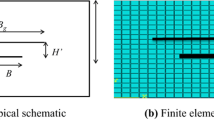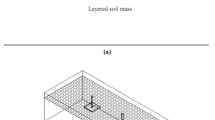Abstract
In this paper, numerical and analytical methods are used to evaluate the ultimate pullout capacity of a group of square anchor plates in row or square configurations, installed horizontally in dense sand. The elasto-plastic numerical study of square anchor plates is carried out using three-dimensional finite element analysis. The soil is modeled by an elasto-plastic model with a Mohr–Coulomb yield criterion. An analytical method based on a simplified three-dimensional failure mechanism is developed in this study. The interference effect is evaluated by group efficiency η, defined as the ratio of the ultimate pullout capacity of group of N anchor plates to that of a single isolated plate multiplied by number of plates. The variation of the group efficiency η was computed with respect to change in the spacing between plates. Results of the analyses show that the spacing between the plates, the internal friction angle of soil and the installation depth are the most important parameters influencing the group efficiency. New equations are developed in this study to evaluate the group efficiency of square anchor plates embedded horizontally in sand at shallow depth (H = 4B). The results obtained by numerical and analytical solutions are in excellent agreement.
























Similar content being viewed by others
References
Abbad H, Meghachou M, Dekar C, Daoud SM (2013) Interaction of rupture zones of adjacent anchor plates in an analogical medium. ETASR Eng Technol Appl Sci Res 3(6):562–565
Ardebili ZA, Gabr MA, Rahman MS (2016) Uplift capacity of plate anchors in saturated clays: analyses with different constitutive models. Int J Geomech 16(2):4015053
Bhattacharya P, Kumar J (2014) Vertical pullout capacity of horizontal anchor plates in the presence of seismic and seepage forces. Geomech Geoeng 9(4):294–302
Bolton MD (1986) The strength and dilatancy of sands. Géotechnique 36(1):65–78
Brinkgreve RBJ, Vermeer PA (2001) Plaxis finite element code for soil and rock analyses, Version 1, BALKEMA
Clemence SP, Veesaert CJ (1977) Dynamic pullout resistance of anchors in sand. In: Proceedings of the international symposium on soil-structure interaction, Roorkee, pp 389–397
Das MB, Yang Jin-Kaun (1987), Uplift capacity of model group anchors in sand. Foundations for transmission line towers, Geotechnical Special Publication No. 8, ASCE
Das BM (1978) Model tests for uplift capacity of foundations in clay. Soils Found 18(2):17–24
Das BM (1983) A procedure for estimation of uplift capacity of rough piles. Soils and Found 23(3):122–126
Das BM (1990) Earth anchors. Dev Geotech Eng 50:1–241
Emirler B, Bildik S, Laman M (2015) Numerical investigation of group anchors. IFCEE 2015 © ASCE 279–288
Ganesh R, Sahoo JP (2015) Influence of ground water on the ultimate uplift resistance of circular plate anchors. In: 50th Indian geotechnical conference 17th–19th December 2015, Pune, Maharashtra, India
Geddes JD, Murray EJ (1996) Plate anchor groups pulled vertically in sand. J Geotech Eng ASCE 122(7):509–516
Ghosh P, Kumari R (2012) Seismic interference of two nearby horizontal strip anchors in layered soil. Nat Hazards 63:789–804
Hanna A, Ayadat T, Sabry M (2007) Pullout resistance of single vertical shallow helical and plate anchors in sand. Geotech Geol Eng 25(5):559–573
Hanna A, Rahman F, Ayadat T (2011) Passive earth pressure on embedded vertical plate anchors in sand. Acta Geotechnica 6(1):21–29
Ilamparuthi K, Dickin EA, Muthukrisnaiah K (2002) Experimental investigation of the uplift behaviour of circular plate anchors embedded in sand. Can Geotech J 39:648–664
Khatri VN, Kumar J (2009) Vertical uplift resistance of circular plate anchors in clays under undrained condition. Comput Geotech 36(8):1352–1359
Khatri VN, Kumar J (2010) Stability of an unsupported vertical circular excavation in clays under undrained condition. Comput Geotech 37(3):419–424
Khatri VN, Kumar J (2011) Effect of anchor width on pullout capacity of strip anchors in sand. Can Geotech J 48(3):511–517
Kouzer KM, Kumar J (2009) Vertical uplift capacity of two interfering horizontal anchors in sand using an upper bound limit analysis. Comput Geotech 36(6):1084–1089
Kouzer KM, Kumar J (2009) Vertical uplift capacity of equally spaced horizontal strip anchors in sand. Int J Geomech 9(5):230–236
Kumar J, Kouzer KM (2008) Vertical uplift capacity of a group of shallow horizontal anchors in sand. Géotechnique 58(10):821–823
Kumar J, Naskar T (2012) Vertical uplift capacity of a group of two coaxial anchors in a general c–φ soil. Can Geotech J 49(3):367–373
Mabrouki A, Mellas M (2014) Étude tridimensionnelle de la capacité ultime des plaques d’ancrage dans un sol frottant. Courrier Du Savoir 18:15–19
Merifield RS, Sloan SW (2006) The ultimate pullout capacity of anchors in frictional soils. Can Geotech J 43(8):852–868
Merifield R S, Lyamin A V, Sloan S W (2006) Three dimensional lower bound solutions for the stability of plate anchors in sand. Géotechnique 56(2):123–132
Merifield RS, Smith CC (2010) The ultimate uplift capacity of multi-plate strip anchors in undrained clay. Comput Geotech 37:504–514
Meyerhof GG, Adams JI (1968) The ultimate uplift capacity of foundations. Can Geotech J 5(4):225–244
Meyerhof GG (1973) Uplift resistance of inclined anchors and piles. In: Proceedings of VIII international conference on soil mechanics and foundation engineering, Moscow, USSR, 2, 1, 167–172
Mors H (1959) The behaviour of mast foundations subject to tensile forces. Bautechnik 10:367–378
Murray EJ, Geddes JD (1987) Uplift of anchor plates in sand. J Geotech Eng 113(3):202–215
Rowe RK, Davis EH (1982) The behaviour of anchor plates in sand. Géotechnique 32(1):25–41
Sahoo JP, Kumar J (2014) Vertical uplift resistance of two closely spaced horizontal strip anchors embedded in cohesive—frictional weightless medium. Can Geotech J 51:223–230
Sahoo JP, Kumar J (2014) Vertical uplift resistance of two interfering horizontal anchors in clay. J Geotech Geoenviron Eng 140(4):06013007
Wang D, Merifield RS, Gaudin C (2013) Uplift behaviour of helical anchors in clay. Can Geotech J 50:575–584
Author information
Authors and Affiliations
Corresponding author
Appendices
Appendix 1: Analytical solution of break-out factor \( \varvec{N}_{{\boldsymbol{\gamma} \,{\textbf{isolated}}}} \) for an isolated square anchor plate
Volumes of the portions 1, 2 and 3 shown in Fig. 25:
The ultimate pullout load \( Q_{u} \) is equal to the weight of the soil located within the failure mechanism:
Using Eqs. 21, 22 and 23, we finally get
By definition, the ultimate pullout capacity \( q_{u} \):
By convention, \( q_{u} \) is also given by:
So that the break-out factor \( N_{\gamma } \) for an isolated square plate anchor is:
Appendix 2: Analytical solution of break-out factor \( \varvec{N}_{{\boldsymbol{\gamma} \,{\textbf{end}}}} \) for a square anchor plate located at an end
For two or n square anchor plates with \( S < 2H\tan \theta \), the ultimate pullout load of one anchor plate at the end is equal to the weight of the soil located within its failure mechanism defined by points a, b, c, d, e shown in Fig. 21.
Volumes of the portions 4 and 5 shown in Fig. 26:
The volume V corresponding to points a, b, c, d, e shown in Fig. 16 is equal to:
where V T is the total volume of soil located within the failure mechanism for an isolated square anchor plate.
So:
The ultimate pullout capacity of anchor plate located at the end is then:
Using Eq. 35, we get
Since
We finally obtained \( N_{{\gamma \,{\text{end}}}} \)
Appendix 3: Analytical solution of break-out factor \( N_{{\gamma \,\text{inter}}} \) for an intermediate square anchor plate
For n square anchor plates in row configuration with \( S < 2H\tan \theta \), the ultimate pullout load of an intermediate anchor plate is equal to the weight of the soil located within its failure mechanism defined by points a, b, c, d, e, f as shown in Fig. 23. The break-out factor corresponding to this volume is noted as \( N_{{\gamma \,{\text{inter}}}} \)
The volume V corresponding to points a, b, c, d, e, f shown in Fig. 18 is equal to:
where V T is the total volume of soil located within the failure mechanism for an isolated square anchor plate.
Using Eqs. (31 and 33), we obtain:
The ultimate pullout capacity of one anchor plate located between two anchor plates is given by:
Since
We get
Rights and permissions
About this article
Cite this article
Mokhbi, H., Mellas, M., Mabrouki, A. et al. Three-dimensional numerical and analytical study of horizontal group of square anchor plates in sand. Acta Geotech. 13, 159–174 (2018). https://doi.org/10.1007/s11440-017-0557-x
Received:
Accepted:
Published:
Issue Date:
DOI: https://doi.org/10.1007/s11440-017-0557-x






